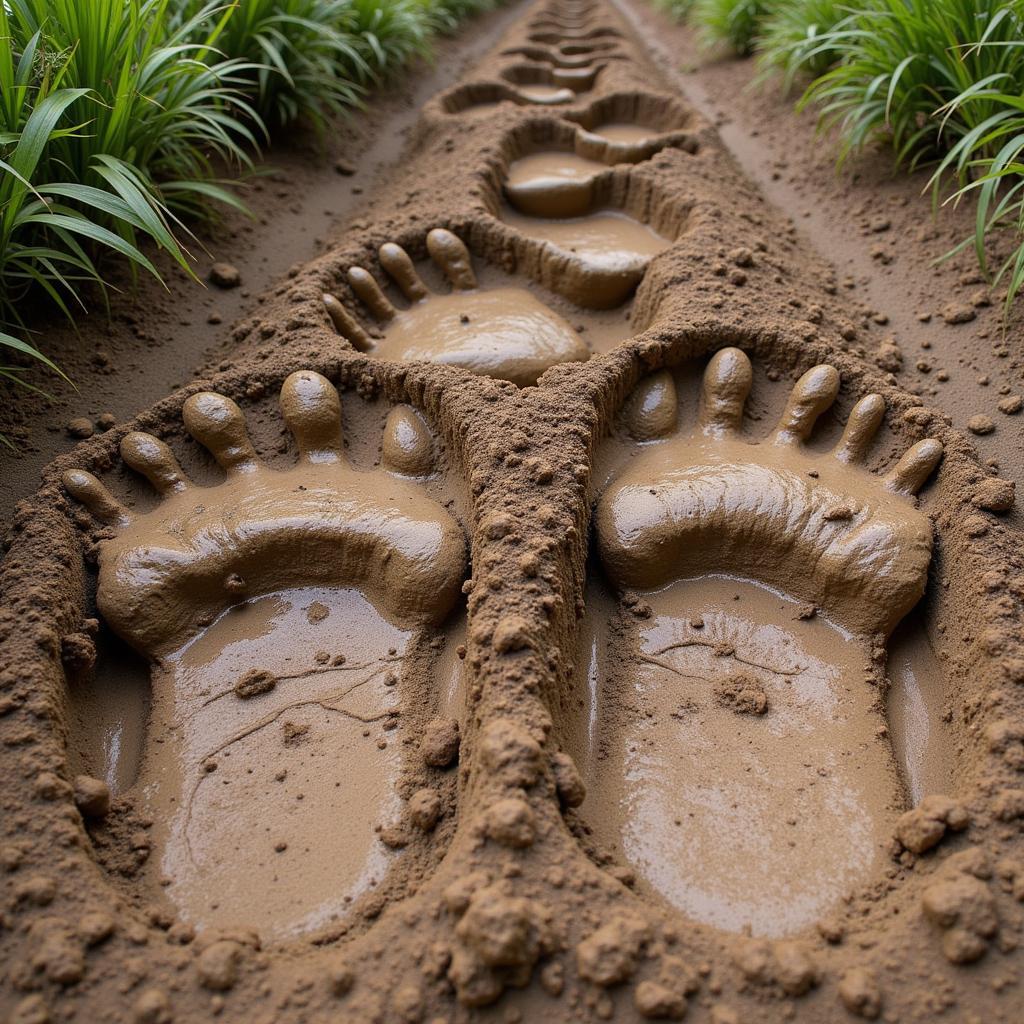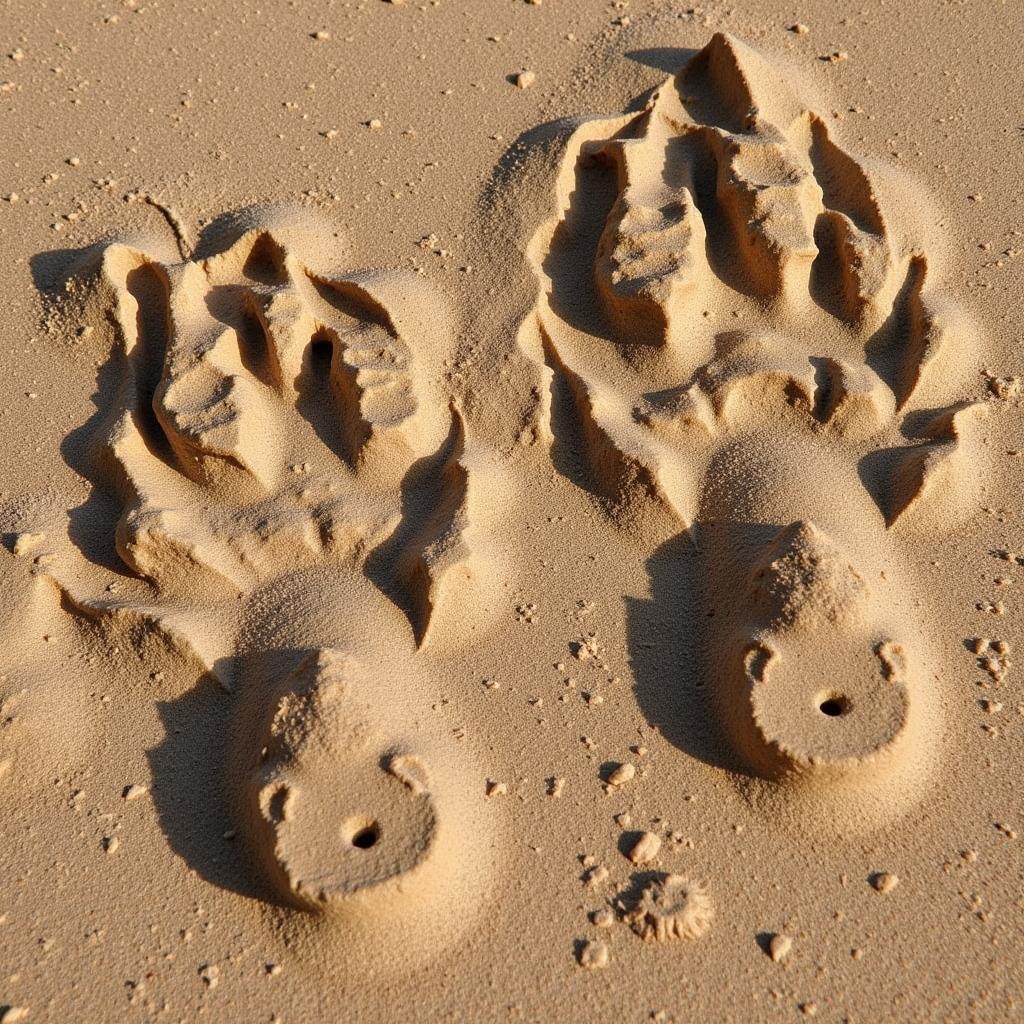Unveiling the Secrets of African Animal Footprints
African Animal Footprints offer a fascinating glimpse into the diverse wildlife that roams this incredible continent. From the subtle imprints of tiny insects to the powerful tracks of elephants, these markings tell stories of survival, migration, and the intricate web of life that connects all creatures. Understanding these footprints can unlock a deeper appreciation for the natural world and aid in conservation efforts.
Deciphering the Clues: Identifying African Animal Footprints
Identifying animal tracks requires careful observation and attention to detail. The shape, size, and depth of the footprint, as well as the gait pattern, can provide valuable clues. For instance, the distinctive three-toed print of a rhinoceros differs greatly from the rounded, padded paw print of a lion. Learning to distinguish these characteristics is essential for accurately identifying the animal that left the track. Even the seemingly small prints of insects can reveal a surprising amount about their behavior and habitat. The african bush elephant animals leave a large and distinct track, recognizable by its size and shape.
 African Elephant Footprints in Mud
African Elephant Footprints in Mud
Common African Animal Footprint Patterns
Certain footprint patterns are common among African animals. Predators, such as lions and leopards, tend to walk with a direct register gait, placing their hind feet in the prints left by their front feet to conserve energy and move stealthily. Prey animals, like zebras and antelopes, often exhibit a more scattered gait, reflecting their need to quickly change direction to evade predators. Understanding these gait patterns can help you determine not only the type of animal but also its behavior at the time the tracks were made.
 African Lion Paw Prints in Sand
African Lion Paw Prints in Sand
What can African animal footprints tell us?
African animal footprints reveal more than just the presence of an animal; they provide insights into its behavior, size, and even its age. Fresh tracks can indicate recent activity, while older, faded prints suggest a passage from some time ago. The depth and size of the print can offer clues about the animal’s weight and age. For instance, a deeper print might suggest a heavier animal or one carrying a load. The stride length can indicate speed and gait, providing clues about the animal’s movement and activity. Did you know that some researchers even use footprint analysis to estimate population sizes and monitor wildlife movements? This information is crucial for conservation efforts.
How to interpret the size and depth of footprints
The size and depth of an african animal footprint can tell a lot about the animal that made it. A larger print generally indicates a larger animal, while a deeper print might suggest a heavier animal or one carrying a load. The african mammoth, though extinct, left behind massive footprints, a testament to its enormous size. Even the depth of a footprint can reveal whether the animal was walking, running, or carrying something heavy.
Professor Charles Okonkwo, a leading zoologist specializing in African wildlife tracking, emphasizes the importance of footprint analysis: “Footprints are a silent language spoken by the animals. By learning to interpret this language, we gain a deeper understanding of their lives and the challenges they face.”
The Impact of Habitat on African Animal Footprints
The type of terrain significantly influences the clarity and preservation of footprints. Soft ground, such as mud or sand, retains impressions well, while harder surfaces like rock may only show faint scratches. Weather conditions also play a role. Rain can wash away tracks, while dry conditions can preserve them for extended periods. Understanding these factors is crucial when tracking animals and interpreting the stories their footprints tell. Reading about the african bigfoot might intrigue those interested in lesser-known creatures and their possible traces.
Conclusion: The Ongoing Story Told by African Animal Footprints
African animal footprints provide a tangible link to the rich and diverse wildlife of the continent. They offer a window into the animals’ lives, behaviors, and the challenges they face in their natural habitats. By learning to interpret these silent stories, we can gain a deeper understanding of the natural world and contribute to the conservation of these incredible creatures. The african forest elephant weight is another interesting aspect of these majestic animals, and their footprints offer clues to their immense size. Learning about African dinosaurs and their footprints can add a historical perspective to the study of animal tracks on the continent.
FAQ
- What are the most common African animal footprints? Common tracks include those of lions, elephants, rhinoceroses, giraffes, and zebras.
- How can I identify different animal footprints? Look for distinct shapes, sizes, and the number of toes or claws. Gait patterns also provide clues.
- What can footprints tell us about an animal’s behavior? Footprints reveal information about an animal’s movement, speed, and activity.
- How does the habitat affect footprint preservation? Soft ground preserves tracks better than hard surfaces, and weather conditions can impact their visibility.
- Why is it important to study animal footprints? Studying footprints helps us understand animal behavior, monitor populations, and inform conservation efforts.
- Where can I learn more about identifying African animal footprints? Field guides, online resources, and nature centers offer valuable information.
- Can I participate in footprint tracking activities in Africa? Yes, many parks and reserves offer guided tracking experiences.
Situations involving footprint questions
- Tracking injured animals: Footprints can help locate injured animals for treatment.
- Monitoring endangered species: Tracking footprints helps researchers monitor populations and movement patterns of endangered species.
- Anti-poaching efforts: Footprint analysis can be used to track poachers and gather evidence.
- Educational programs: Footprint identification is often incorporated into educational programs for children and adults.
Related questions and articles:
- How to identify bird tracks in Africa
- The impact of climate change on animal migration patterns
- The best places to observe wildlife in Africa
When you need support, contact us by phone: +255768904061, email: [email protected] or visit our address: Mbarali DC Mawindi, Kangaga, Tanzania. We have a 24/7 customer service team.

